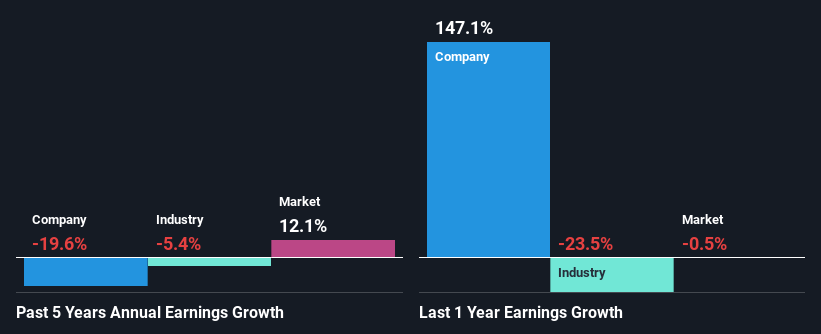Stock Analysis
- United Kingdom
- /
- Food
- /
- LSE:TATE
Are Tate & Lyle plc's (LON:TATE) Mixed Financials Driving The Negative Sentiment?

Tate & Lyle (LON:TATE) has had a rough three months with its share price down 6.6%. It seems that the market might have completely ignored the positive aspects of the company's fundamentals and decided to weigh-in more on the negative aspects. Stock prices are usually driven by a company’s financial performance over the long term, and therefore we decided to pay more attention to the company's financial performance. In this article, we decided to focus on Tate & Lyle's ROE.
Return on Equity or ROE is a test of how effectively a company is growing its value and managing investors’ money. In short, ROE shows the profit each dollar generates with respect to its shareholder investments.
Check out our latest analysis for Tate & Lyle
How To Calculate Return On Equity?
The formula for ROE is:
Return on Equity = Net Profit (from continuing operations) ÷ Shareholders' Equity
So, based on the above formula, the ROE for Tate & Lyle is:
14% = UK£173m ÷ UK£1.2b (Based on the trailing twelve months to September 2023).
The 'return' is the yearly profit. That means that for every £1 worth of shareholders' equity, the company generated £0.14 in profit.
What Has ROE Got To Do With Earnings Growth?
We have already established that ROE serves as an efficient profit-generating gauge for a company's future earnings. Depending on how much of these profits the company reinvests or "retains", and how effectively it does so, we are then able to assess a company’s earnings growth potential. Generally speaking, other things being equal, firms with a high return on equity and profit retention, have a higher growth rate than firms that don’t share these attributes.
Tate & Lyle's Earnings Growth And 14% ROE
To start with, Tate & Lyle's ROE looks acceptable. Especially when compared to the industry average of 7.8% the company's ROE looks pretty impressive. As you might expect, the 20% net income decline reported by Tate & Lyle is a bit of a surprise. Therefore, there might be some other aspects that could explain this. Such as, the company pays out a huge portion of its earnings as dividends, or is faced with competitive pressures.
As a next step, we compared Tate & Lyle's performance with the industry and found thatTate & Lyle's performance is depressing even when compared with the industry, which has shrunk its earnings at a rate of 5.4% in the same period, which is a slower than the company.

The basis for attaching value to a company is, to a great extent, tied to its earnings growth. It’s important for an investor to know whether the market has priced in the company's expected earnings growth (or decline). Doing so will help them establish if the stock's future looks promising or ominous. What is TATE worth today? The intrinsic value infographic in our free research report helps visualize whether TATE is currently mispriced by the market.
Is Tate & Lyle Using Its Retained Earnings Effectively?
Tate & Lyle's high three-year median payout ratio of 113% suggests that the company is depleting its resources to keep up its dividend payments, and this shows in its shrinking earnings. Its usually very hard to sustain dividend payments that are higher than reported profits.
Additionally, Tate & Lyle has paid dividends over a period of at least ten years, which means that the company's management is determined to pay dividends even if it means little to no earnings growth. Upon studying the latest analysts' consensus data, we found that the company's future payout ratio is expected to drop to 35% over the next three years. Regardless, the ROE is not expected to change much for the company despite the lower expected payout ratio.
Summary
On the whole, we feel that the performance shown by Tate & Lyle can be open to many interpretations. Despite the high ROE, the company has a disappointing earnings growth number, due to its poor rate of reinvestment into its business. Having said that, looking at current analyst estimates, we found that the company's earnings growth rate is expected to see a huge improvement. To know more about the company's future earnings growth forecasts take a look at this free report on analyst forecasts for the company to find out more.
Valuation is complex, but we're helping make it simple.
Find out whether Tate & Lyle is potentially over or undervalued by checking out our comprehensive analysis, which includes fair value estimates, risks and warnings, dividends, insider transactions and financial health.
View the Free AnalysisHave feedback on this article? Concerned about the content? Get in touch with us directly. Alternatively, email editorial-team (at) simplywallst.com.
This article by Simply Wall St is general in nature. We provide commentary based on historical data and analyst forecasts only using an unbiased methodology and our articles are not intended to be financial advice. It does not constitute a recommendation to buy or sell any stock, and does not take account of your objectives, or your financial situation. We aim to bring you long-term focused analysis driven by fundamental data. Note that our analysis may not factor in the latest price-sensitive company announcements or qualitative material. Simply Wall St has no position in any stocks mentioned.
About LSE:TATE
Tate & Lyle
Tate & Lyle PLC, together with its subsidiaries, provides ingredients and solutions to the food, beverage, and other industries in the United States, the United Kingdom, other European countries, and internationally.
Very undervalued with proven track record.

